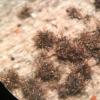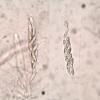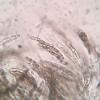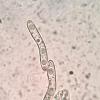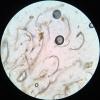
16-11-2025 21:09
 Robin Isaksson
Robin Isaksson
Anyone recognize this acc. to pictures.? Found on

14-11-2025 16:26
 Marian Jagers
Marian Jagers
Hello everyone, On dead wood of Cytisus scoparius

15-11-2025 23:22
Mario FilippaHello,this is what I think to be Hymenoscyphus mac

15-11-2025 20:25
 Riet van Oosten
Riet van Oosten
Hello, Found by Laurens van der Linde, Nov. 2025

14-11-2025 18:31
 Lothar Krieglsteiner
Lothar Krieglsteiner
Hello,can somebody provide me with a file of:Rothe

12-11-2025 09:25
 Viktorie Halasu
Viktorie Halasu
Hello, I need help with a pale terrestric Pseudom

11-11-2025 20:16
Bohan JiaHi, lastly I have found these tiny yellow decayin

09-11-2025 13:20
Hello.A tiny ascomycete, appearing as erupting gra
Could you check if the hair dissolves in KOH?
I checked my collections at KOH, but I don't have enough of them to have opinions on this subject.
The collection that I designated as E. canescens had hair that did not dissolve in KOH. In E. strigosa, however, the hair immediately melted.
I wonder if this feature can be helpful in identification and will this reaction be confirmed when testing a larger number of collections?
Pictures of such collections I saw on Zotto disk and I wonder why I can't find information on this subject in literature.
A photo of the hair dissolved by KOH, I also posted on my website with this species (Photo 15-16):
http://www.grzyby-pk.pl/gat_e/gat_echinosphaeria_strigosa.php
Is this feature insignificant?
Is it found in all species of this genus or only in some? Or maybe such a reaction depends on other factors?
I would like to know the opinions of others on this topic?
Mirek
Thank you for checking reaction on KOH.
My experience with these mushrooms is small but I think your determination is correct.
I was hoping that someone more familiar with this kind would say something about the reaction.
Regards
Mirek

I also looked at Declercq's 2016 paper and that's why this feature made me wonder.
Andrew N. Miller maybe conducted such tests?
Mirek

Thank you, Zotto.
I thought about it because a few years ago, P. Perz mentioned such a reaction. In one of my collections, this reaction did not occur, which made me wonder.
Mirek

there are other microscopic features of Echinosphaeria I'm rather curious about, e.g. spore ornamentation. Bell & Mahoney (see below) mention finely punctate spores for their new E. incondita and E. leucolanosa, finely spinulose for E. strigosa and E. similistrigosa sp n, or longitudinally striate spores for E. striatispora sp n and E. stuppea.
Further they described new E. similistrigosa with intermediate spore size between canescens and strigosa (without knowing Declercq's species published in the same year). Perforated septum (E. medusa) or germ pores on overmature spores (E. minuta sp. n.) are other characters I never heard about in this genus.
Bell A., Mahoney D. (2016): Field studies in the Lasiosphaeriaceae and Helminthosphaeriaceae sensu lato. CBS Biodiversity Series 15. 124 p., Utrecht, CBS-KNAW Fungal Biodiversity Centre.
Viktorie
P.S. I only have a scanned copy of the book, the mentioned characters are well visible on drawings, not so much on microphotos. But that's probably due to low scanning resolution.

